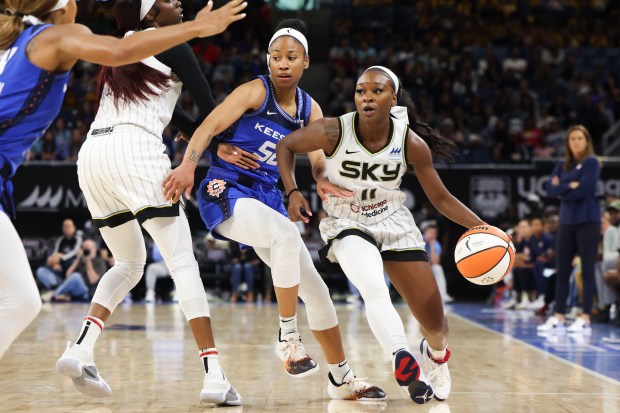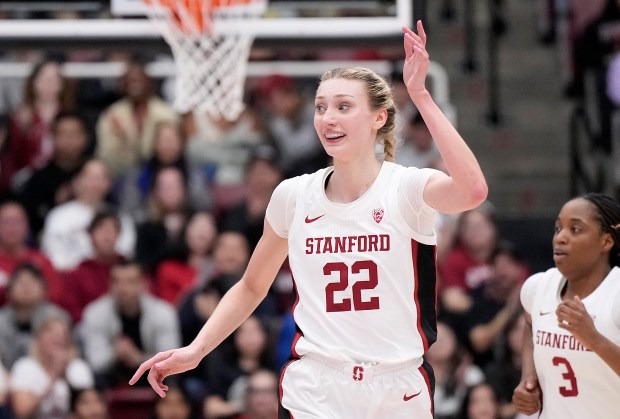The championship era is over for the Chicago Sky.
When Kahleah Copper left in a trade with the Phoenix Mercury last week, she took with her the final pillar of the 2021 WNBA champs, a clear punctuation mark at the end of that chapter for the franchise.
This is worth mourning in itself for the city — after all, the Sky brought home Chicago’s first championship since the 2016 Cubs.
But for new coach Teresa Weatherspoon and general manager Jeff Pagliocca, Copper’s exit is also clarifying. When they assumed their roles in October — splitting the coach and GM positions for the first time in franchise history — they inherited the struggles of the previous regime.
At the center of those struggles was Copper, a talented wing and rising star in the league who had chosen to give the Sky another chance despite the sudden departure of her last coach. Copper’s two-year contract extension created an incredibly short runway — rebuild around the three-time All-Star at a breakneck pace or risk losing her again in 2026.
No team is better without Copper on its roster. But now the task for Weatherspoon and Pagliocca settles into a more reasonable challenge: building a roster through the draft while making the Sky a more attractive destination for free agents.
When it came to 2021, the Sky were incredibly fortunate. The players said that themselves: How many .500 teams make it all the way to the finals? They survived the first two rounds under the old playoff structure, beating the Dallas Wings and Minnesota Lynx in single elimination to reach the semifinals.
None of this undercuts the quality of that team, which was backed up by a franchise-best 26-10 regular season in 2022. But it reflects how much luck comes into play to win a single championship.
Building a dynasty, on the other hand — that’s not luck. That takes patience, pragmatism and a whole lot of work behind the scenes. And if the Sky have their sights on building something close to that under Weatherspoon, the rebuild that Copper’s exit necessitates will offer a clear runway to begin that lengthy process.
There are a couple of obvious steps to set off that process effectively, for both the front office and ownership.
1. Make the most of the 2024 draft.
The Sky got back into the mix with the Copper trade after former coach and general manager James Wade gave away the majority of their draft capital in a deal for Marina Mabrey last year. While Pagliocca will have to continue untangling the mess of that trade, the Sky are in good position with the No. 3 pick in a deep 2024 draft.
With many players weighing the option of using their additional COVID year of eligibility, it’s hard to predict who will be available in this year’s draft. But the class should be stacked nonetheless.
The Sky don’t have a single player they drafted on their current roster, reflecting a poor history of selections. This is their first year with a first-round pick since 2021, when they drafted Shyla Heal at No. 8 and then traded her less than three weeks into the season for Dana Evans — who had been available when the Sky picked Heal.
The Sky won’t get Caitlin Clark, who is a lock to be the No. 1 pick. But the top 10 will be filled with league-ready players who can contribute as rookies — especially bigs such as Cameron Brink, Kamilla Cardoso, Aaliyah Edwards, Rickea Jackson and Alissa Pilli.
2. Figure out the point guard position.

The Sky fumbled this spot last season with a failed attempt to convert Courtney Williams to the role in her eighth season while bringing Evans off the bench. They can’t afford to make the same mistake this season.
The core of the starting lineup — Mabrey, wing Diamond DeShields and center Elizabeth Williams — thrives in a spread-out offense in which they can play off the ball and pick teams apart with inside-out ball movement. This can be a successful look for the Sky, but it requires an on-ball guard who can prevent stagnation and feed her teammates.
Cementing the point guard spot will be one of Weatherspoon’s first major personnel decisions. Is Evans ready for the starting gig? If not, where can the Sky find a reliable facilitator?
This is where the WNBA’s lack of roster space can be an asset to rebuilding teams. The Sky have invited two former No. 4 picks — guards Chennedy Carter (2020) and Kysre Gondrezick (2021) — to training camp. They also could extend an invitation to former No. 1 pick Charli Collier (2021), a 6-foot-5 center whom the Wings waived before last season, to diversify their options.
While Pagliocca and Weatherspoon tackle these tasks, the Sky ownership group and Operating Chairman Nadia Rawlinson face a hurdle of their own: following through on promises of investment.
Perhaps the steepest growth curve in the WNBA over the last five years has been the increase in player demand for designated training facilities. The Las Vegas Aces became the first in the league last year to build their own stand-alone facilities — not connected to a men’s team.
Most players in the league don’t have their own lockers, much less access to a court where they can practice during off hours. The Sky still train at Sachs Recreation Center, a community center in Deerfield where players walk past senior water aerobics classes on their way to the court — which is accessible only during normal working hours of 5 a.m. to 9 p.m.
When compared with the Advocate Center — where Chicago Bulls players have 24/7 access to multiple hoops, treatment facilities, film rooms and more — it’s understandable why these facilities are the focus for investment from players, coaches and executives alike.
Adding capital to the ownership group was a key first step last year. The Sky clearly needed deeper pockets to compete with the rest of the league, which will only get wealthier with impending expansion. And Rawlinson expressed urgency last year for the Sky to build their own training facility when the Sachs lease comes up this year.
It’s time to follow through with more concrete plans. The Sky are still behind — but that doesn’t have to last forever as long as ownership is serious about investment.
So, no, this isn’t a new championship era — yet. But this season is critical for the Sky to build a foundation for a more sustainable version of success.
Step one is less than two months away when the WNBA draft takes place April 15.



